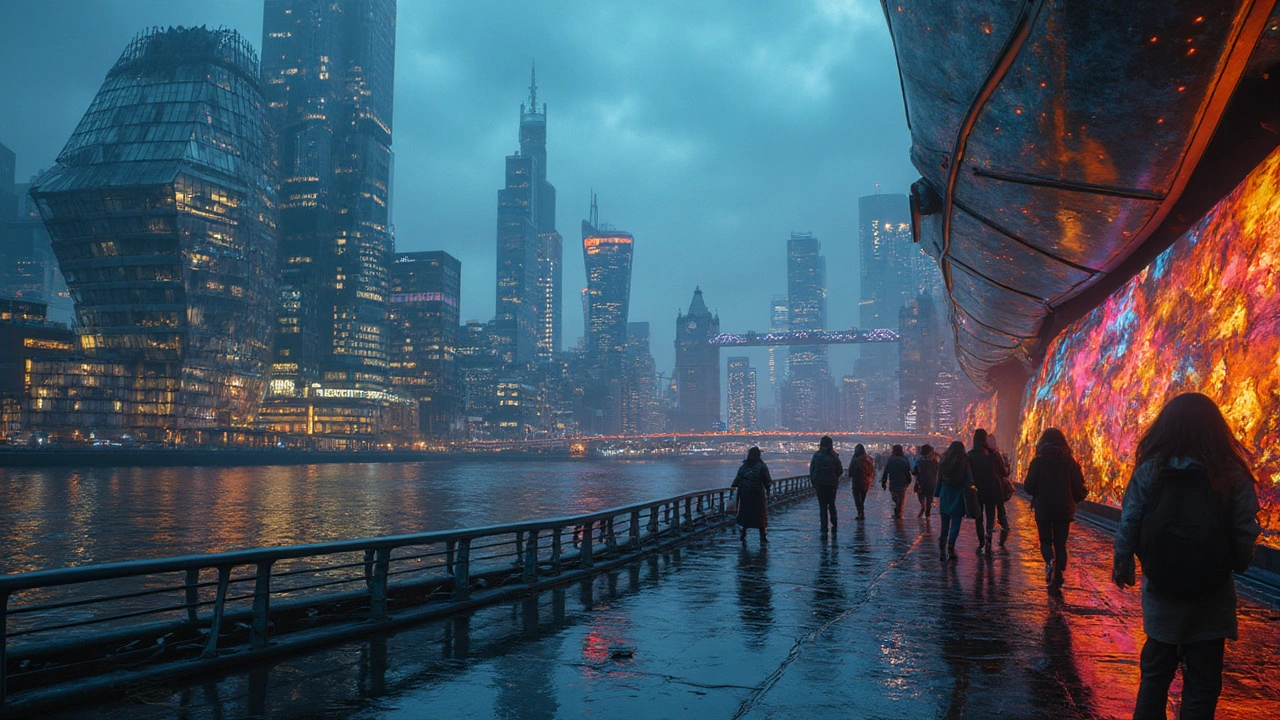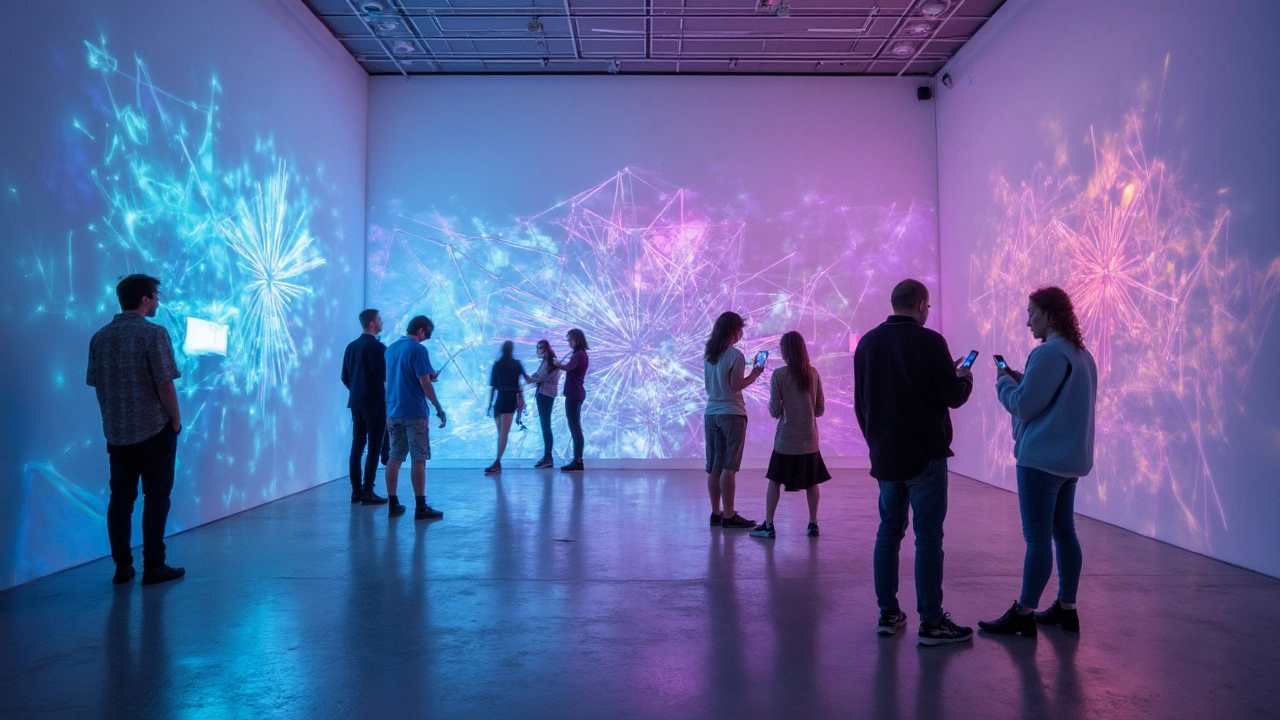Neo-Futurism: How It's Shaping Contemporary Art Today
 Aug, 18 2025
Aug, 18 2025
Want to know why museums are swapping out Monet for mind-bending light installations? Neo-Futurism is rewriting the rules of what counts as art in 2025. If you’re feeling a little lost in the swirl of code-driven sculptures and VR murals, stick with me—this movement is loud, unpredictable, and not at all what your art teacher promised.
What is Neo-Futurism? The Fast Facts
At its heart, neo-futurism cares less about pretty pictures and more about what the future could look, feel, and sound like. It’s a movement that mixes tech, design, sustainability, and sometimes even activism. Think of it as futurism’s rebellious grandkid: less about speed and more about the digital, the ecological, and the experience. Neo-futurist artists don’t just paint; they hack, code, 3D-print, and experiment with AI as if it’s just another brush.
The roots go back to the early 1980s, with architects like Zaha Hadid and Santiago Calatrava fusing engineering, organic forms, and bold optimism. Fast forward to today, and the vibe has exploded well beyond buildings. Visual artists, installation geniuses, and performance rebels across the globe grab from the neo-futurist toolkit to challenge what art can be.
| What Sets Neo-Futurism Apart? | Traditional Contemporary Art | Neo-Futurist Art |
|---|---|---|
| Mediums | Painting, Sculpture, Photography | VR, AI, Generative Art, Robotics |
| Inspiration | Pop culture, history | Science, tech, digital futures |
| Audience Role | Passive viewer | Interactive participant |
The Neo-Futurist Playbook: Techniques & Elements
So, what are these artists actually doing? Here’s the toolkit:
- Tech-first approach: Expect AR, VR, AI, and even blockchain popping up anywhere you see the term “Neo-Futurism.” Algorithms can generate the art, and viewers might interact or alter it on the fly.
- Sustainable materials: No movement today gets away with ignoring the planet. Using recycled plastics, solar power, or upcycled e-waste is almost a given.
- Experiential installations: Neo-futurist art lives to be touched, walked through, scanned with your phone, or even worn. Static is boring.
- Fluid boundaries: Painting meets performance. Soundtracks sync with biometric data. If it breaks a boundary, it probably belongs here.
The Tate Modern’s 2024 "Future Forms" exhibit was the talk of London because it mashed together art, robotics, and viewer participation. Guests wrote texts that an AI sculpture reshaped into physical patterns in real time. No one left wondering what "interactive" means anymore.
Game-Changing Examples in 2025
Neo-futurism doesn’t live in just one place. Here’s where it makes art feel like a science fair at warp speed:
- In Tokyo, Wanda Hsu’s "BioLoops" installation had living algae spirals hooked to sensors; visitors’ heartbeats changed the patterns of light and growth.
- New York’s Tribeca Hotspot recently hosted "My City, Our Code," where people edited cityscape projections using their smartphones. By the end, the gallery’s walls didn’t look the same as when you walked in.
- Berlin’s "After The Flood" by Otto Neumann let viewers step through a storm of recycled water bottles, with real-time weather data controlling soundscapes and visuals. It blended activism, tech, and performance into one wild walk-through.
According to the respected critic Dana Leoni, who reviewed the Venice Biennale’s 2025 focus on the future,
“Neo-Futurist art is rewriting the definition of audience, turning ‘spectators’ into co-creators. The line between artist and viewer has officially dissolved.”

Neo-Futurism’s Impact: Why Artists and Audiences Care
It’s not hype—neo-futurism changes who gets to make art and what art even is. Three-quarters of new art installations at major global museums this year use at least one advanced digital process, based on stats from the International Association of Art Critics.
For artists, it’s about shaping the world and pushing against stale limits. They love that they can blend science and storytelling, or invite the audience to play along. For viewers, it’s way more hands-on and unforgettable. TikTok is full of viral videos from these immersive, shareable installations. People leave with more than a selfie—they leave thinking about the future, and their place in it.
| Impact Point | Artists | Audience |
|---|---|---|
| Access | More tools (coding, 3D printing) | More access (open-source tools) |
| Involvement | Collaborative creation | Interactive participation |
| Awareness | Pushes awareness of AI, climate, social issues | Firsthand experience |
How to Spot Neo-Futurism and Join the Conversation
If you want to keep up, look for these markers:
- Is technology more than just a tool? (Is it shaping the art?)
- Does the artwork ask for, or even need, your feedback or presence?
- Are the materials or methods making a point about the future or the environment?
- Do you walk away feeling like you collaborated rather than just observed?
To get involved: sign up for interactive events at local museums, follow Neo-Futurist collectives online, or even play with open-source code art platforms (like p5.js or TouchDesigner). Schools and summer camps now offer maker’s labs that let anyone take a crack at VR or AI-powered art.
But watch your step—some works only make sense during the exhibit or require tech you need to download, and the experience can be hit or miss for people craving “traditional” art.
Mini-FAQ: Fast Answers to Burning Questions
- Is Neo-Futurism just hype or a real shift?
It’s real and here to stay; artists and critics both see it as the shape of art to come, according to the Museum of Modern Art’s 2025 trend report. - Do I need to be tech-savvy to enjoy it?
Not usually. The best Neo-Futurist work is designed for everyone, regardless of gadget skills. - Why is it suddenly everywhere?
The explosion in affordable tech, plus climate and social challenges, pushed creatives to innovate with new forms. - Is sustainability always involved?
Almost always, yes. Environmental awareness is “baked in” for most leading artists in this scene, especially in 2025. - Where can I see Neo-Futurist art in person?
Major cities’ museums, digital art and design festivals, and some public spaces offer shows—check for local listings.
If you’re craving art that’s alive, unpredictable, and tied to the biggest questions of this century, don’t sleep on Neo-Futurism. Whether you’re out to make it, experience it, or just want some TikTok-worthy photos, this movement’s reforming what art means for everyone.